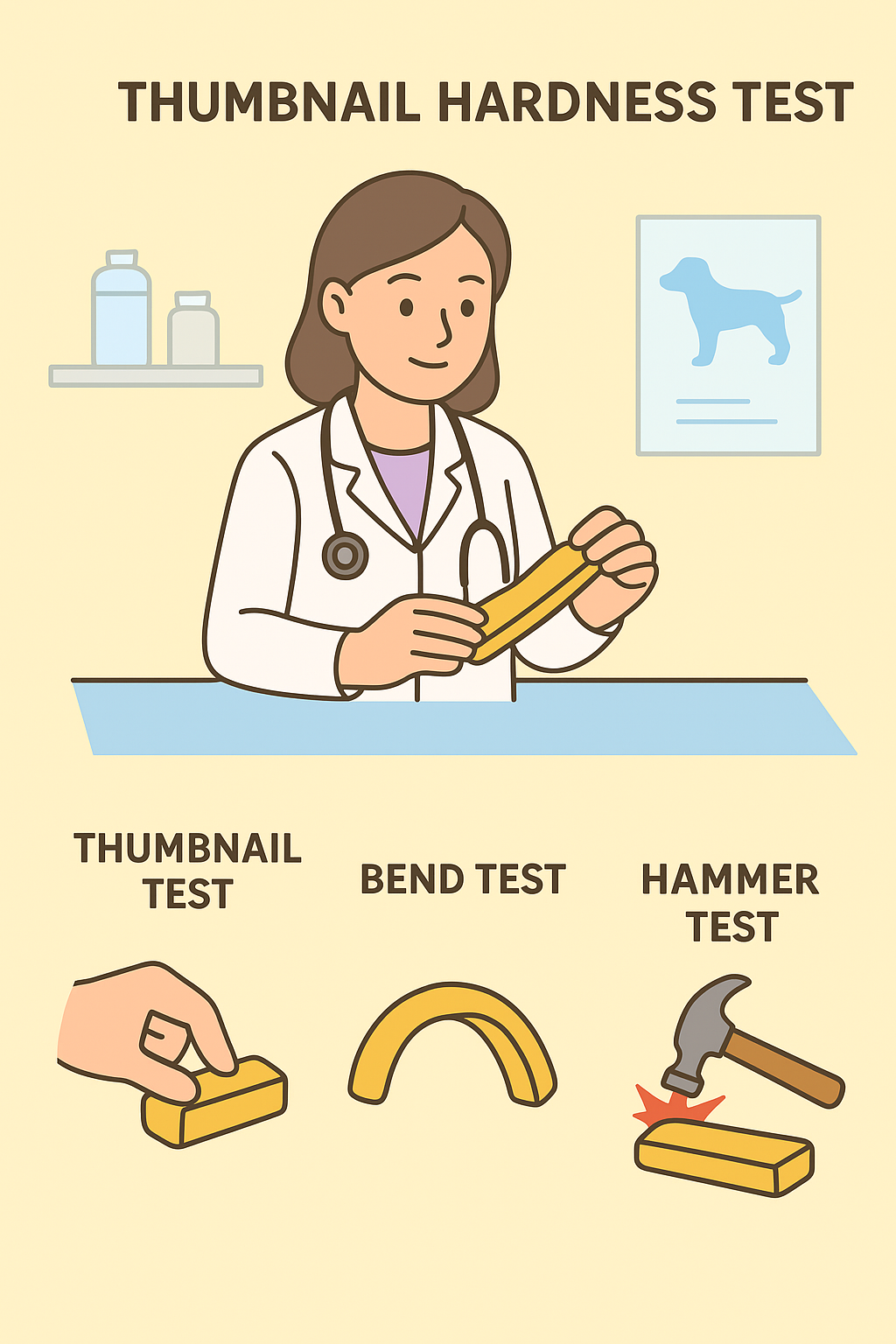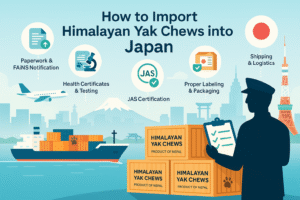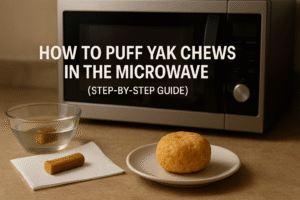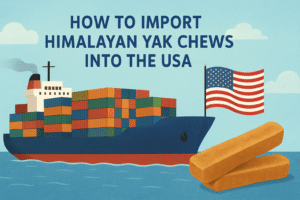When it comes to choosing safe and effective chews for puppies, pet parents often ask about the suitability of popular natural options like Himalayan yak chews. These chews have gained widespread popularity for their long-lasting nature, natural ingredients, and potential dental benefits.
Himalayan yak chews are generally not recommended for puppies under 6 months old due to their extreme hardness, which can cause cracked teeth, jaw injuries, and choking hazards in young dogs whose teeth and jaws are still developing. Some veterinarians, however, may allow cautious introduction from around 4 months for certain breeds or individuals with stronger teeth and jaws always under strict supervision, choosing the right size, limiting chewing sessions to 10-15 minutes, and promptly removing small pieces to prevent choking. Offering Best Yak chews gradually and ensuring fresh water is available during chewing also supports safer consumption and digestion.
However, their extreme hardness raises important safety concerns, especially for puppies with developing teeth and jaws. This vet-reviewed guide unpacks the facts, scientific perspectives, and practical tips on Himalayan yak chews’ safety for puppies detailing age recommendations, potential risks, and expert advice to help you make an informed decision tailored to your puppy’s unique needs.
What Are Himalayan Yak Chews?
Himalayan yak chews, also known as yak cheese chews, are traditional long-lasting treats from the Himalayan regions of Nepal, Tibet, and Bhutan. Made primarily from yak or a blend of yak and cow milk, lime juice, and salt, the mixture is boiled, curdled, strained, compressed, and dried over weeks to months, resulting in a rock-hard, shelf-stable chew. They boast:
- High protein content: 60–70%
- Low fat: ~1–2%
- Rich in calcium and phosphorus
- Low lactose (due to fermentation and drying), making them mostly digestible for many dogs.
Despite these appealing nutritional benefits, their extreme hardness introduces risks for puppies, especially those with more fragile, developing teeth.
Do Veterinarians recommend Hard Yak Chews for Puppies?

Vets often apply simple hardness tests you can try at home:
- Thumbnail test: If you can’t dent it with your thumbnail, it’s too hard.
- Bend test: If it won’t bend under pressure, it’s risky.
- Hammer test: If it would hurt your knee if you hit it, it can hurt your dog’s teeth.
Most Himalayan yak chews fail these tests, highlighting their potential for dental injury. Authorities like the American Animal Hospital Association (AAHA) and Veterinary Oral Health Council (VOHC) advise against giving extremely hard chews to young dogs, whose deciduous (baby) teeth and newly erupting adult teeth are vulnerable to fractures.
When can a puppy safely have yak chews?
- 0–8 weeks: Nursing stage; no chews needed.
- 8–16 weeks: Baby teeth (soft deciduous teeth) present; hard chews risk pain and breakage.
- 4–6 months: Adult teeth begin erupting but remain sensitive; some veterinarians may permit soft introduction of harder chews depending on individual development.
- 6+ months: All adult teeth usually fully in; jaw muscles stronger, suitable for harder chews with supervision.
Key takeaway: Introducing yak chews before 6 months significantly increases dental injury risk, but veterinarian advice and individual puppy maturity can sometimes allow earlier, careful introduction from around 4 months.
What are the Safety Considerations for Puppies?
While Himalayan yak chews can be a healthy and enjoyable treat, puppies have unique needs and vulnerabilities that require careful attention. Ensuring safety is crucial to prevent dental injuries, choking, or digestive issues.
1. Hardness of Yak Chews
Himalayan yak chews are extremely hard, which can pose a risk to a puppy’s developing teeth and jaws. Puppies’ teeth are softer and more fragile than adult dogs’, so it’s important to introduce these chews gradually and monitor for any signs of discomfort or damage.
2. Recommended Age for Introduction
Most experts recommend waiting until a puppy is around 4–6 months old before offering Himalayan yak chews. By this age, their adult teeth are stronger, making them better equipped to handle the chew without risking fractures or excessive wear.
3. Size Selection Based on Breed and Weight
Choosing the right size chew is critical. A chew that’s too small can become a choking hazard, while one that’s too large may be difficult for the puppy to manage. Generally, the chew should be large enough that the puppy cannot fit the entire piece in its mouth.
4. Choking Hazards and Digestive Concerns
Puppies can break off small, hard pieces that may become lodged in the throat or cause intestinal blockage. Always supervise chewing sessions and remove any small fragments that could be swallowed accidentally. Avoid giving yak chews to aggressive chewers who may bite off large chunks.
5. Supervision Tips
- Limit chewing sessions to 10–15 minutes for young puppies.
- Observe signs of frustration, choking, or difficulty chewing.
- Always provide fresh water nearby to help with swallowing and digestion.
6. Signs of Chewing Problems
Watch for warning signs such as:
- Broken or chipped teeth
- Excessive drooling or pawing at the mouth
- Vomiting, diarrhea, or constipation
- Reluctance to chew or sudden aggression with the chew
By following these safety guidelines, Himalayan yak chews can be a safe and enjoyable treat that supports a puppy’s dental health and natural chewing instincts.
What risks do yak chews pose to puppies?
The Risk of Himalayan Yak Chews for Puppies are Given Below:
- Dental Fractures: Young dogs frequently fracture teeth chewing very hard objects.
- Choking Hazard: Small, broken-off pieces can lodge in the throat or cause gagging; watch for signs like excessive drooling, coughing, pawing at mouth, or reluctance to chew.
- Gastrointestinal Blockage: Large indigestible chunks may block intestines, a medical emergency.
- Digestive Upset & Allergies: Despite low lactose, some puppies have dairy protein sensitivities or allergies that cause vomiting, diarrhea, or stomach discomfort.
- Bacterial Contamination: Natural chews left moist can harbor bacteria that always discard old or soggy chews.
How to Safely Introduce Yak Chews for Puppies?
If your veterinarian approves and your puppy is 6 months or older (or possibly a bit younger with stronger teeth):
- Choose a chew size larger than your puppy’s mouth width to prevent swallowing whole.
- Limit chewing sessions to 10–15 minutes to reduce injury and digestive risk.
- Supervise every chew session closely, and immediately remove small pieces or nubs.
- Safely soften leftover small pieces by microwaving them submerged in water for 30–60 seconds (“puffing” method), creating a softer, crunchy treat that is easier to chew and less risky.
What are the Benefits of Himalayan Yak Chews for Puppies?
The Benefits of Himalayan Yak Chews for Puppies are supported Dental Health, Long-Lasting Entertainment, Natural, Single-Ingredient Treat, Low Odor and Easy Digestibility and Encourages Positive Chewing Habits. Himalayan yak chews offer several advantages for puppies when introduced safely and appropriately. While puppies have more sensitive teeth and jaws than adult dogs, these chews can still provide both physical and mental benefits under supervision.
1. Supports Dental Health
Chewing is essential for a puppy’s developing teeth and gums. Himalayan yak chews are hard and durable, which helps reduce plaque and tartar buildup while gently massaging the gums. This can promote healthier teeth as puppies transition from baby teeth to adult teeth.
2. Long-Lasting Entertainment
Puppies are naturally energetic and curious, and chewing can help satisfy their instinctual need to gnaw. Himalayan yak chews are slow-to-consume treats that keep puppies occupied, reducing boredom-related behaviors like chewing on furniture or shoes.
3. Natural, Single-Ingredient Treat
Made primarily from yak and cow milk, Himalayan yak chews are free from artificial preservatives, colors, and flavors. Puppies can enjoy a wholesome, natural snack that aligns with a healthy diet, making them a safer alternative to heavily processed treats.
4. Low Odor and Easy Digestibility
Unlike some other chews, Himalayan yak chews are low in odor and easily digestible, which makes them puppy-friendly for both indoor use and multi-pet households. Their lactose is reduced during the making process, minimizing the risk of digestive upset for sensitive puppies.
5. Encourages Positive Chewing Habits
Introducing a puppy to an appropriate chew early helps teach them what’s safe to chew. Himalayan yak chews can train puppies to chew on designated items rather than household objects, establishing healthy lifelong habits.
Ensure a Safe Chewing Environment
Provide a quiet, distraction-free area to help your puppy focus on safe chewing behavior, minimizing risks of gulping or accidental choking caused by sudden excitements or interruptions.
Safer Puppy Chew Alternatives
| Chew Type | Age Suitability | Hardness | VOHC Approved? | Notes |
| Puppy Kong (frozen) | 8 weeks+ | Soft rubber | No | Excellent for teething relief |
| Frozen carrot | 8 weeks+ | Medium | No | Natural, affordable |
| VOHC puppy dental chew | 12 weeks+ | Soft-medium | Yes | Specifically designed for dental health |
| Nylon puppy bone | 8 weeks+ | Medium | No | Softer than adult nylon bones |
Pro Tip: Rotate between soft and moderately hard chews during teething phases to keep puppies engaged, reduce boredom, and protect teeth.
Can 8 week old puppies have yak chews?
No, it is generally not recommended to give Himalayan yak chews While some pet owners give Himalayan yak chews to puppies as young as 8 weeks, experts generally recommend starting these chews around 4 to 6 months of age, when the puppy’s adult teeth are stronger and better suited for safely handling hard chews. Yak chews may ease teething discomfort and support dental health, but their hardness can damage teeth or cause choking in young puppies whose teeth are still developing. When giving yak chews to an 8-week-old puppy, supervise closely, choose a size that fits their small mouth, and monitor for signs of choking or digestive upset. Some owners soften small leftover pieces by soaking them in warm water or briefly microwaving them to make chewing safer. Consult your vet before giving yak chews to a young puppy so they can assess your puppy’s dental development, chewing strength, and risk of injury.
What age is safer for yak chews?
The safest age for puppies to start having yak chews is generally around 4 to 6 months old. This timing allows puppies to have developed their adult teeth enough to chew safely without risking chipped teeth or choking hazards. It’s crucial to supervise puppies during chewing sessions, start with smaller or softer yak chews to accommodate their developing jaws, and limit intake to prevent overconsumption. Veterinarians recommend introducing yak chews once puppies have a full set of adult teeth, around 4 months or older, as they provide dental health benefits and essential nutrients. Always consult your vet if you are uncertain about your puppy’s readiness to start yak chews, ensuring a safe and enjoyable chewing experience for your young dog.
Are yak chews digestible?
Yes, Yak chews are generally considered digestible for dogs. They are made from natural ingredients, often through a fermentation process that reduces lactose, which makes them gentle on dogs’ digestive systems. Unlike some commercial treats, yak chews do not contain fillers or artificial additives, which contributes to their high digestibility and lowers the risk of gastrointestinal upset. Many veterinarians recommend yak chews as safe and beneficial, especially for dogs with sensitive stomachs, since they minimize digestive discomfort. However, it is still important to introduce them gradually and supervise your dog while chewing to ensure they tolerate them well and avoid any potential issues.
Do yak chews clean teeth?
Yes, Yak chews can help clean a dog’s teeth. The chewing action on yak chews works like a natural toothbrush, helping to remove plaque and tartar buildup from teeth. This abrasive process promotes healthier teeth and gums, supports better oral hygiene, and can reduce bad breath. Additionally, the chewing stimulates saliva production, which further helps cleanse the mouth and reduce bacteria. Yak chews soften naturally with saliva as dogs chew, allowing their teeth to penetrate the chew more effectively, almost creating a flossing effect that enhances dental cleanliness. Overall, yak chews are considered beneficial for maintaining dental health in dogs through mechanical cleaning and natural ingredients.
How long should my puppy chew on one?
The recommended chewing time for your puppy on a yak chew is generally around 10 to 15 minutes to start, with close supervision to ensure they chew safely and don’t ingest large pieces. For older puppies or adult dogs, chew sessions can be extended to about 30 to 40 minutes per session. If your puppy is chewing off big bits and swallowing them, it’s best to limit the chew time to prevent digestive issues or choking hazards. Yak chews are designed to soften gradually as your dog chews, providing a long-lasting chewing experience that supports dental health without splintering, but moderation and supervision are key to keeping it safe for your puppy. Always provide fresh water during and after chewing sessions and consult your vet if you’re unsure about how long your puppy should chew based on their size and chewing habits.
10–15 minutes per session under strict supervision.
What about small leftover pieces?
Small leftover pieces of yak chews can pose a choking hazard to dogs and are generally not considered safe to leave for your dog to chew on. Once a yak chew has been gnawed down to small fragments, these pieces become risky because dogs might accidentally swallow them whole, leading to choking or digestive issues. To keep your dog safe, it is important to remove any small leftover pieces promptly. Some owners soften small pieces by microwaving them to “puff” them up, making a safer, crunchy snack, especially for puppies or smaller dogs with more sensitive jaws. Always supervise your dog while chewing and replace the yak chew when it has worn down to small bits to avoid any hazards. This cautious approach helps provide a safe and enjoyable chewing experience while protecting your pet from possible choking or digestive discomfort.
What signs mean I should stop immediately?
You should stop giving your dog a yak chew immediately if you observe signs of choking or distress, such as coughing, gagging, difficulty breathing, or pawing at the mouth. Additionally, stop if your dog is swallowing large or sharp pieces that could cause choking or digestive blockage. Other warning signs include sudden vomiting, diarrhea, signs of allergic reaction like itching or skin rashes, and any indication of oral pain such as reluctance to chew or excessive drooling. Close supervision during chewing is essential to catch these signs early. If any of these symptoms appear, remove the yak chew right away and consult your veterinarian to ensure your dog’s safety. These precautions help prevent choking hazards, digestive issues, and dental injuries associated with yak chews.
What age can a puppy have a yak chew?
Puppies can have a yak chew starting from about 4 months of age, once they have developed their adult teeth sufficiently to chew safely. Introducing yak chews too early can risk dental damage or choking hazards, so supervision during chewing is important to ensure safety.
Do vets recommend yak chews?
Veterinarians generally recommend yak chews due to their natural ingredients, dental health benefits, and digestibility. They emphasize moderation and close supervision during chewing, especially for puppies, to prevent potential choking or digestive problems.
What age can dogs have Himalayan dogs chew?
Himalayan dog chews are recommended for dogs over 12 weeks (3 months) of age. Their hardness means they require dogs to be old enough and have sufficient chewing strength to avoid dental injuries, so consideration of the dog’s age and chewing habits is necessary before giving these chews.
Are yak chews too hard for puppy teeth?
Yak chews can be quite hard and may be too tough for very young puppies’ teeth, which are still developing and more fragile. For this reason, they are not advised for puppies younger than 4 months, as their teeth and jaws might not handle the hardness well, potentially causing dental problems. Choosing appropriate chew sizes and monitoring chewing sessions carefully is essential to prevent injury.
Final Recommendation
Himalayan yak chews are best avoided for puppies under 6 months. Even older puppies should only have these chews under veterinarian guidance, with close supervision, in appropriately sized chews, and for brief chewing sessions. For younger puppies, softer, vet-approved teething toys and chews are safer and better suited for growing mouths.
Always consult your veterinarian before introducing any new chew, especially very hard natural treats like yak chews, to ensure your puppy’s dental health and overall well-being.







